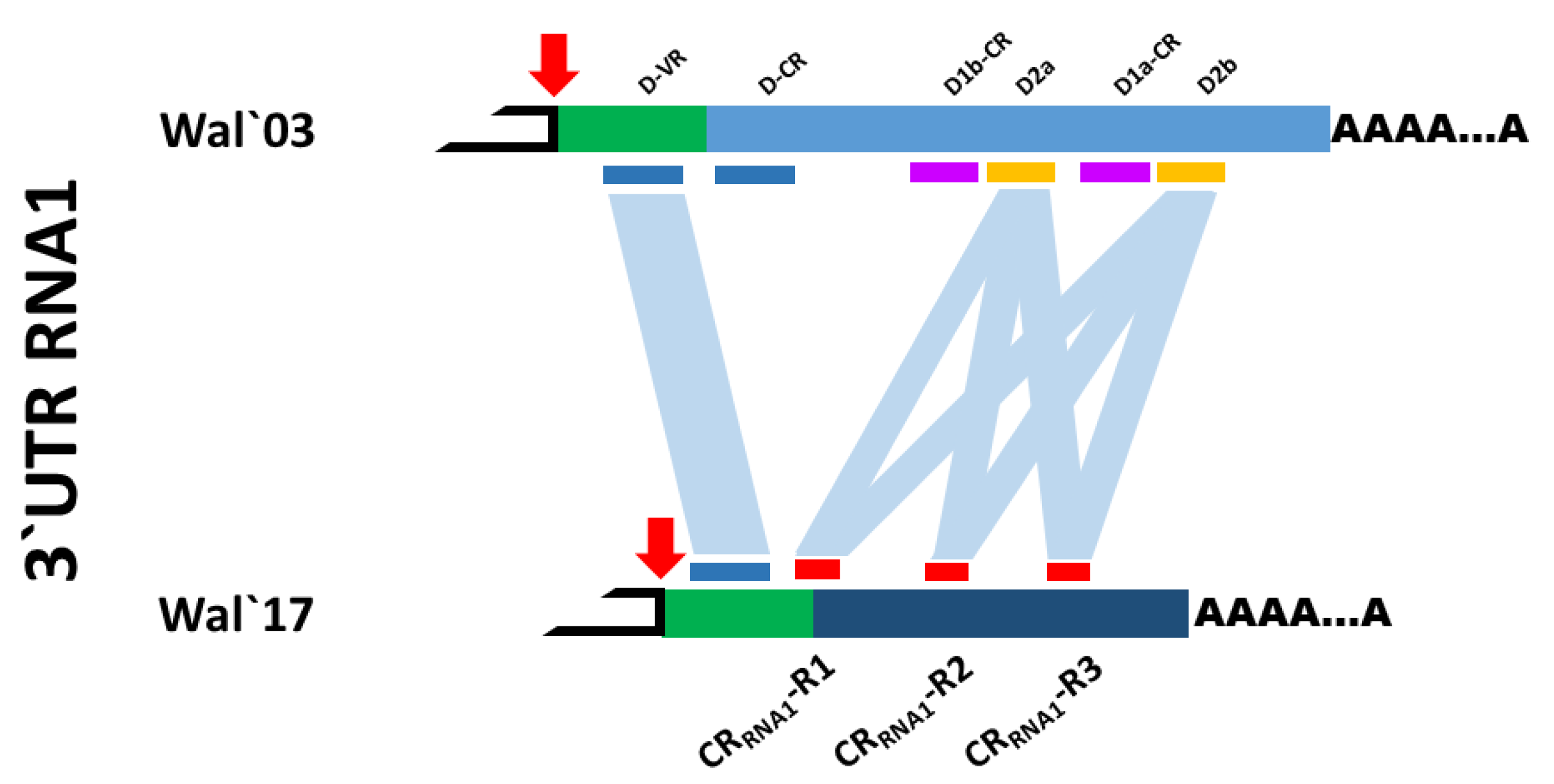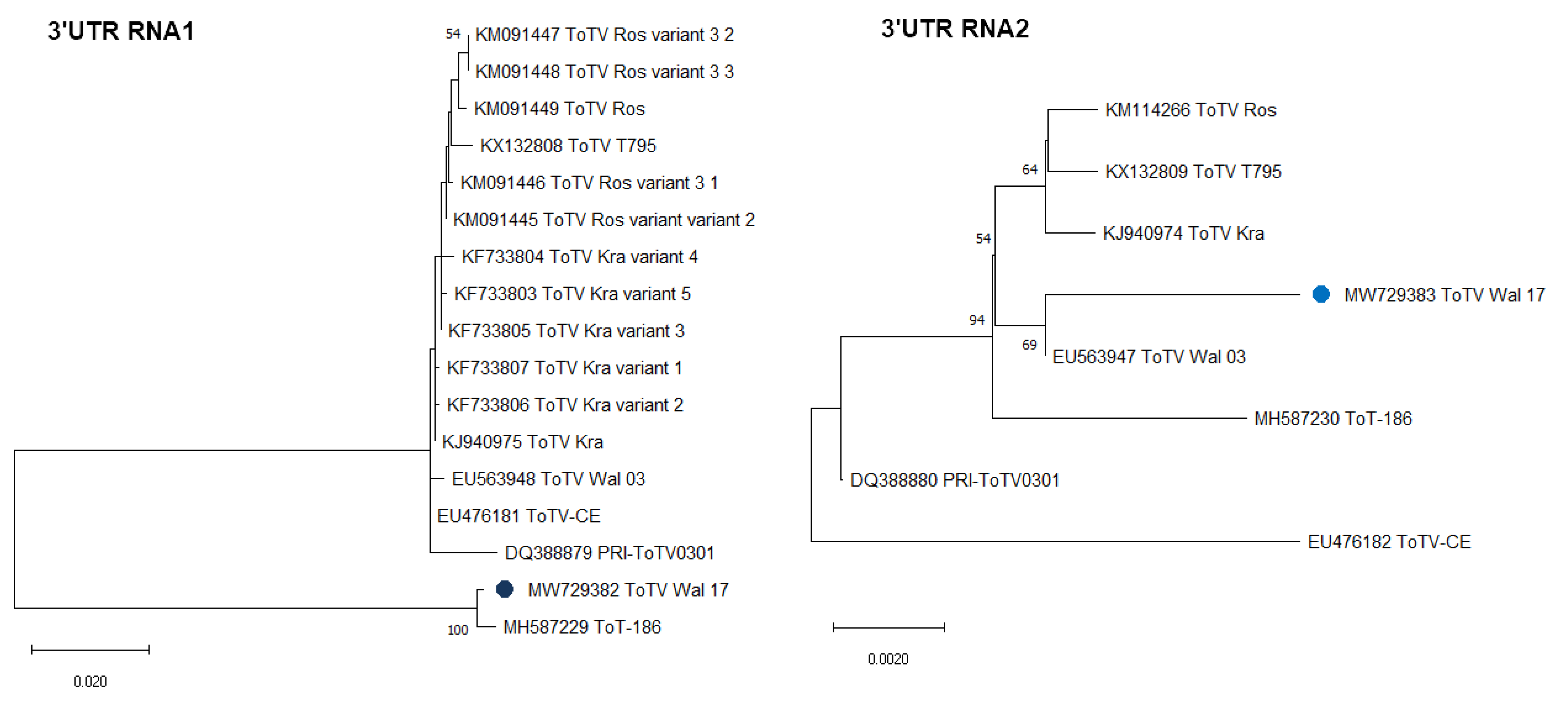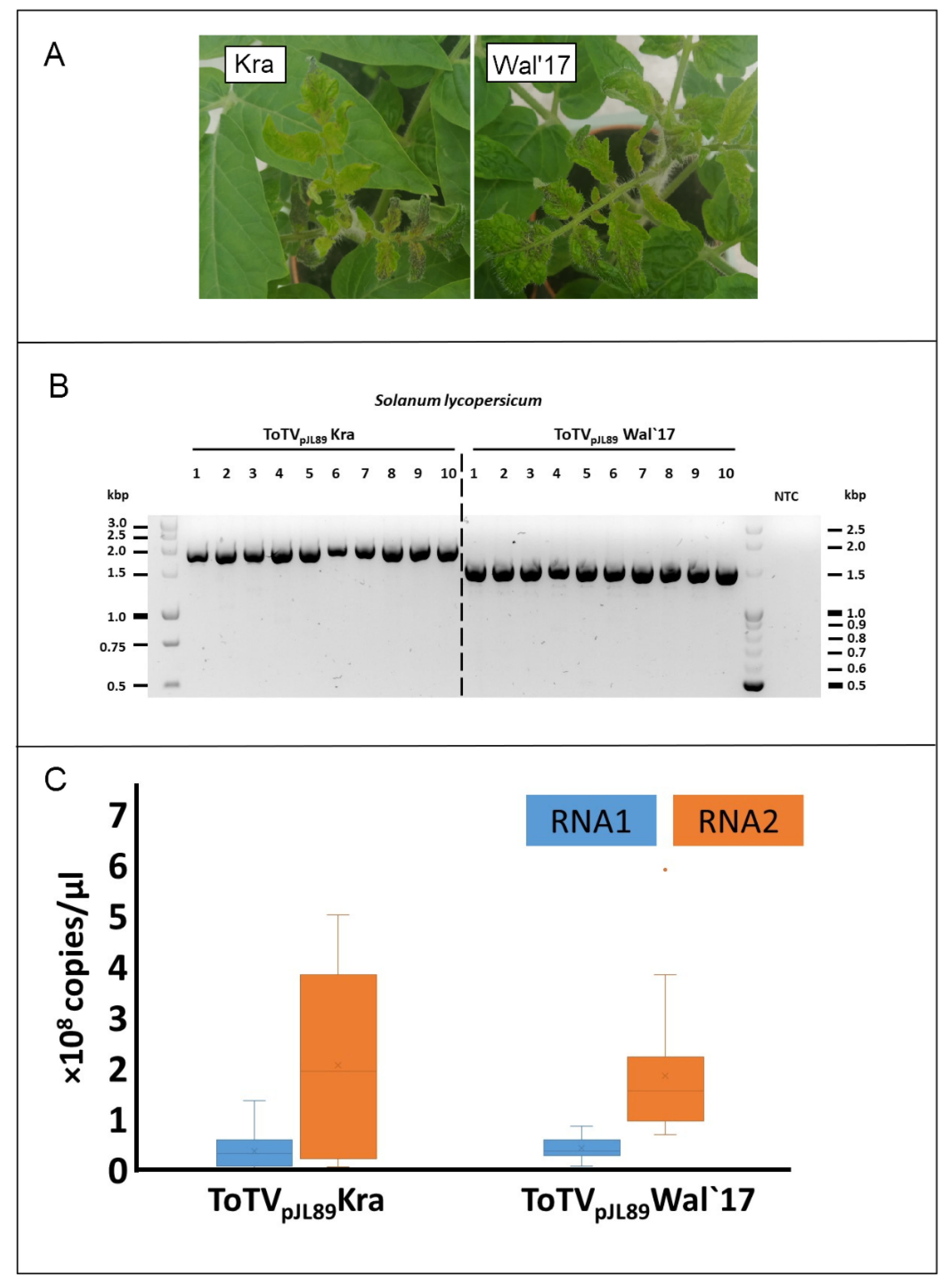A Novel Distinct Genetic Variant of Tomato Torrado Virus with Substantially Shorter RNA1-Specific 3’Untranslated Region (3’UTR)
Abstract
1. Introduction
2. Materials and Methods
3. Results and Discussion
3.1. Analysis of 5’Untranslated Regions (5’UTRs)
3.2. Analysis of Coding Sequences (CDS)
3.3. Analysis of 3’Untranslated Regions (3’UTRs)
Author Contributions
Funding
Institutional Review Board Statement
Informed Consent Statement
Data Availability Statement
Acknowledgments
Conflicts of Interest
References
- Sanfaçon, H.; Wellink, J.; Le Gall, O.; Karasev, A.; der Vlugt, R.; Wetzel, T. Secoviridae: A proposed family of plant viruses within the order Picornavirales that combines the families Sequiviridae and Comoviridae, the unassigned genera Cheravirus and Sadwavirus, and the proposed genus Torradovirus. Arch. Virol. 2009, 154, 899–907. [Google Scholar] [CrossRef]
- Verbeek, M.; Dullemans, A.M.; Maris, P.; van den Heuvel, J.; van der Vlugt, R.A.A. The genus Torradovirus, a new plant virus genus. In Proceedings of the International Advances in Plant Virology, Joint meeting of Association of Applied Biologists & Dutch Circle of Plant Virologists, Ithaca, NY, USA, 20–24 June 2010. [Google Scholar]
- Verbeek, M.; Dullemans, A.M.; den Heuvel, J.; Maris, P.C.; der Vlugt, R.A.A. Identification and characterisation of tomato torrado virus, a new plant picorna-like virus from tomato. Arch. Virol. 2007, 152, 881–890. [Google Scholar] [CrossRef] [PubMed][Green Version]
- Budziszewska, M.; Obrepalska-Steplowska, A.; Wieczorek, P.; Pospieszny, H. The nucleotide sequence of a Polish isolate of Tomato torrado virus. Virus Genes 2008, 37, 400–406. [Google Scholar] [CrossRef] [PubMed]
- Pospieszny, H.; Budziszewska, M.; Hasiów-Jaroszewska, B.; Obrępalska-Stęplowska, A.; Borodynko, N. Biological and molecular characterization of Polish isolates of Tomato torrado virus. J. Phytopathol. 2010, 158, 56–62. [Google Scholar] [CrossRef]
- Pospieszny, H.; Borodynko, N.; Obrepalska-Steplowska, A.; Hasiow, B. The first report of Tomato torrado virus in Poland. Plant Dis. 2007, 91, 1364. [Google Scholar] [CrossRef] [PubMed]
- Alfaro-Fernández, A.; Córdoba-Sellés, C.; Cebrián, M.C.; Herrera-Vásquez, J.A.; Sánchez-Navarro, J.A.; Juárez, M.; Espino, A.; Martin, R.; Jordá, C. First report of Tomato torrado virus on weed hosts in Spain. Plant Dis. 2008, 92, 831. [Google Scholar] [CrossRef][Green Version]
- Alfaro-Fernández, A.; Bese, G.; Córdoba-Sellés, C.; Cebrián, M.C.; Herrera-Vásquez, J.A.; Forray, A.; Jordá, C. First report of tomato torrado virus infecting tomato in Hungary. Plant Dis. 2009, 93, 554. [Google Scholar] [CrossRef]
- Alfaro-Fernández, A.; Córdoba-Sellés, C.; Cebrián, M.C.; Sánchez-Navarro, J.A.; Espino, A.; Martin, R.; Jordá, C. First report of tomato torrado virus in tomato in the Canary Islands, Spain. Plant Dis. 2007, 91, 1060. [Google Scholar] [CrossRef] [PubMed]
- Verdin, E.; Gognalons, P.; Wipf-Scheibel, C.; Bornard, I.; Ridray, G.; Schoen, L.; Lecoq, H. First report of Tomato torrado virus in tomato crops in France. Plant Dis. 2009, 93, 1352. [Google Scholar] [CrossRef]
- Herrera-Vasquez, J.A.; Alfaro-Fernández, A.; Cordoba-Selles, M.C.; Cebrian, M.C.; Font, M.I.; Jordá, C. First report of Tomato torrado virus infecting tomato in single and mixed infections with Cucumber mosaic virus in Panama. Plant Dis. 2009, 93, 198. [Google Scholar] [CrossRef]
- Davino, S.; Bivona, L.; Iacono, G.; Davino, M. First report of Tomato torrado virus infecting tomato in Italy. Plant Dis. 2010, 94, 1172. [Google Scholar] [CrossRef]
- Gambley, C.F.; Thomas, J.E.; Persley, D.M.; Hall, B.H. First report of Tomato torrado virus on tomato from Australia. Plant Dis. 2010, 94, 486. [Google Scholar] [CrossRef]
- Verbeek, M.; Dullemans, A.M. First Report of Tomato torrado virus infecting tomato in Colombia. Plant Dis. 2012, 96, 592. [Google Scholar] [CrossRef]
- Afechtal, M. First report of tomato torrado virus (ToTV) infecting tomato in Morocco. J. Plant Pathol. 2020, 102, 1327. [Google Scholar] [CrossRef]
- Moodley, V.; Gubba, A.; Mafongoya, P.L. Emergence and full genome analysis of tomato torrado virus in South Africa. Viruses 2020, 12, 1167. [Google Scholar] [CrossRef] [PubMed]
- Vucurovic, A.; Kutnjak, D.; Mehle, N.; Stanković, I.; Pecman, A.; Bulajic, A.; Krstic, B.; Ravnikar, M. Detection of four new tomato viruses in Serbia using post-hoc high-throughput sequencing analysis of samples from a large-scale field survey. Plant Dis. 2021. [Google Scholar] [CrossRef]
- Wieczorek, P.; Budziszewska, M.; Frackowiak, P.; Obrepalska-Steplowska, A. Development of a new tomato torrado virus-based vector tagged with GFP for monitoring virus movement in plants. Viruses 2020, 12, 1195. [Google Scholar] [CrossRef] [PubMed]
- Wieczorek, P.; Budziszewska, M.; Obrępalska-Stęplowska, A. Construction of infectious clones of tomato torrado virus and their delivery by agroinfiltration. Arch. Virol. 2015, 160, 517–521. [Google Scholar] [CrossRef][Green Version]
- Budziszewska, M.; Wieczorek, P.; Zhang, Y.; Frishman, D.; Obrępalska-Stęplowska, A. Genetic variability within the polish tomato torrado virus Kra isolate caused by deletions in the 3′-untranslated region of genomic RNA1. Virus Res. 2014, 185, 47–52. [Google Scholar] [CrossRef] [PubMed]
- Budziszewska, M.; Pospieszny, H.; Obrepalska-Steplowska, A. Genome characteristics, phylogeny and varying host specificity of Polish Kra and Ros isolates of tomato torrado virus. J. Phytopathol. 2016, 164, 281–285. [Google Scholar]
- Roossinck, M.J. Mechanisms of plant virus evolution. Annu. Rev. Phytopathol. 1997, 35, 191–209. [Google Scholar] [PubMed]
- Hall, T.; Biosciences, I.; Carlsbad, C. BioEdit: An important software for molecular biology. GERF Bull. Biosci. 2011, 2, 60–61. [Google Scholar]
- Kumar, S.; Stecher, G.; Li, M.; Knyaz, C.; Tamura, K. MEGA X: Molecular evolutionary genetics analysis across computing platforms. Mol. Biol. Evol. 2018, 35, 1547–1549. [Google Scholar] [CrossRef] [PubMed]
- Yoshida, T.; Kitazawa, Y.; Komatsu, K.; Neriya, Y.; Ishikawa, K.; Fujita, N.; Hashimoto, M.; Maejima, K.; Yamaji, Y.; Namba, S. Complete nucleotide sequence and genome structure of a Japanese isolate of hibiscus latent Fort Pierce virus, a unique tobamovirus that contains an internal poly (A) region in its 3′ end. Arch. Virol. 2014, 159, 3161–3165. [Google Scholar] [CrossRef] [PubMed]
- Guo, S.; Wong, S.M. Poly (A) introduced upstream of the upstream pseudoknot domain of Tobacco mosaic virus led to sequence deletion after serial passaging in host plants. Phytopathol. Res. 2019, 1, 1–12. [Google Scholar]
- Rodriguez-Cerezo, E.; Klein, P.G.; Shaw, J.G. A determinant of disease symptom severity is located in the 3′ -terminal noncoding region of the RNA of a plant virus. Proc. Natl. Acad. Sci. USA 1991, 88, 9863–9867. [Google Scholar] [CrossRef] [PubMed]
- May, J.P.; Yuan, X.; Sawicki, E.; Simon, A.E. RNA virus evasion of nonsense-mediated decay. PLoS Pathog. 2018, 14, e1007459. [Google Scholar] [CrossRef] [PubMed]



| RNA Strand | Silent Mutations | Missense Mutations | ||
|---|---|---|---|---|
| Nucleotide change | Functional domain | Nucleotide change (amino acid change) | Functional domain | |
| RNA1 | 830G > A | Prot | 346T > A (V80D) | 11K |
| 1574C > T | Hel | |||
| 1905G > A (D600N); 2058C > T (Y651H); 2242A > G (N712S); 2504G > C (K799N) | Hel | |||
| 1964C > T 2216G > A; 2612T > C | Hel/Prot | |||
| 3500A > G; 3734C > T; | Prot/RdRP | 3436T > C (V1110A) | Prot/RdRP | |
| 4124T > C 4256T > C 4496C > T | RdRP | |||
| 5603G > A 5810C > T 6101C > T 6473C > T | RdRP/3’UTR | |||
| 4762G > A (R1552K) | RdRP | |||
| 5843G > C (Q1912H) | RdRP/3’UTR | |||
| RNA2 | 632G > A | ORF1 | 1863A > C (N388H); 1865T > C (N388H); 1866C > A (H389N); 2001C > T (L434F) | 3A |
| 2573T > C | Vp35 | |||
Publisher’s Note: MDPI stays neutral with regard to jurisdictional claims in published maps and institutional affiliations. |
© 2021 by the authors. Licensee MDPI, Basel, Switzerland. This article is an open access article distributed under the terms and conditions of the Creative Commons Attribution (CC BY) license (https://creativecommons.org/licenses/by/4.0/).
Share and Cite
Budziszewska, M.; Wieczorek, P. A Novel Distinct Genetic Variant of Tomato Torrado Virus with Substantially Shorter RNA1-Specific 3’Untranslated Region (3’UTR). Plants 2021, 10, 2454. https://doi.org/10.3390/plants10112454
Budziszewska M, Wieczorek P. A Novel Distinct Genetic Variant of Tomato Torrado Virus with Substantially Shorter RNA1-Specific 3’Untranslated Region (3’UTR). Plants. 2021; 10(11):2454. https://doi.org/10.3390/plants10112454
Chicago/Turabian StyleBudziszewska, Marta, and Przemysław Wieczorek. 2021. "A Novel Distinct Genetic Variant of Tomato Torrado Virus with Substantially Shorter RNA1-Specific 3’Untranslated Region (3’UTR)" Plants 10, no. 11: 2454. https://doi.org/10.3390/plants10112454
APA StyleBudziszewska, M., & Wieczorek, P. (2021). A Novel Distinct Genetic Variant of Tomato Torrado Virus with Substantially Shorter RNA1-Specific 3’Untranslated Region (3’UTR). Plants, 10(11), 2454. https://doi.org/10.3390/plants10112454







